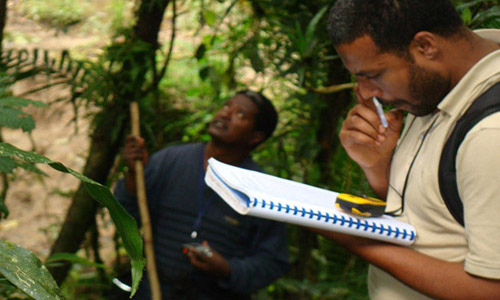Research Facilities
The Environmental Studies department is home to several research facilities for graduate students to use, in addition to a number of research facilities available on campus.

Center for Agroecology & Sustainable Food Systems
The program is a research and education group working toward the development of sustainable agricultural systems. It gives high priority to forging links with farmers, gardeners, researchers, and faculty at other facilities. It manages two facilities: the 25-acre Farm on a lower meadow of campus and the four-acre Alan Chadwick Garden on the upper campus. The Farm is the primary research facility and includes research plots, raised-bed gardens, row crops, orchards, a laboratory, and a solar greenhouse. Graduate students may arrange to use the facilities as part of their course work or research.
Computing Facilities, and CISR
The Department of Environmental Studies maintains a graduate computing facility for the exclusive use of its students, in addition to the more specialized geographic information systems facility mentioned below. The campus as a whole also maintains computer labs for student use.
The Department of Environmental Studies hosts the campus Center for Integrated Spatial Research (CISR), formerly the GIS/ISC Laboratory, which serves as a central facility for spatially-focused research and training at the UCSC. CISR is focused on integrating state-of-of-the-art spatial technology, methods, and data (geographic information systems, global positioning systems, remote sensing, spatial modeling/statistics) with pressing interdisciplinary research and fostering cross-domain cooperation in the application of these tools. Graduate students engaged in spatially-focused courses and research projects have access to facilities managed by CISR. For more information go to http://spatial.cisr.ucsc.edu

Greenhouses at UCSC
The Research greenhouses are located on the roofs of Sinsheimer Labs, the Interdisciplinary Sciences Building (ISB) and Thimann Labs. These greenhouses provide support for faculty, post docs, researchers, visiting faculty, graduate, and undergraduate students doing plant-related research in the departments of Molecular, Cellular and Developmental Biology (MCD), Ecology and Evolutionary Biology (EEB) and Environmental Studies (ENVS). There are ten separate greenhouse, ten Conviron E15 growth chambers, eight Percival incubators, two labs and two rooftop outdoor areas dedicated to research. These staffed facilities are stocked with an assortment of research equipment.

McHenry and Science Libraries
The University Library consists of two facilities: McHenry Library, which provides centralized support for instruction and research in the humanities, arts, and social sciences, and the Science and Engineering Library which supports scientific and technical research. The University Library contains over 1.25 million volumes, nearly 9,000 periodical titles, and over 500,000 non print items. Both locations provide group study rooms, computers, and wireless access to digital resources. Cruzcat, the local catalog provides holdings, links, and material descriptions of UCSC resources. MELVYL® the UC systemwide catalog indexes the holdings of all UC libraries and Interlibrary Loan services expand UCSC's information base to the UC system; there is also access to the Stanford University libraries. Off campus access to all digital resources is available to affiliated students.

UCSC Arboretum
The campus Arboretum is a research and teaching facility containing representatives of nearly 300 plant families. Greenhouse facilities are available for research, and special collections of conifers, primitive angiosperms, and plant families of the Southern Hemisphere are available for study.

Museum of Natural History Collections
The Museum of Natural History Collections (MNHC) is dedicated to cultivating an increased understanding of and appreciation for the natural world by promoting the use of its natural science collections for teaching, research, and aesthetics. The museum is the main repository for natural science collections at UC Santa Cruz. Collections include specimens of plants, insects, fishes, amphibians, reptiles, birds, and mammals. The museum loans specimens for use in teaching, research, and artwork to faculty, students, staff, associates, and others. In addition, the museum maintains the department's field-equipment pool. Equipment such as measuring tapes, thermometers, binoculars, and soil-sampling kits are loaned to students and others working on class, internship, or independent study-related field projects.

UC Natural Reserves
The University of California Natural Reserve System (NRS) provides access to and maintains 34 natural areas that encompass diverse and undisturbed examples of California's terrain, both aquatic and terrestrial. The reserves were established for teaching and research. Although graduate students may work on any of the reserves, the Santa Cruz campus has administrative responsibility for four: the former Ft. Ord military site, Landels-Hill Big Creek Reserve, Younger Lagoon, and Año Nuevo Island. In addition, the 400-acre UCSC campus reserve includes a remarkably diverse array of communities to study.

